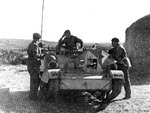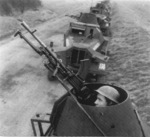Boys Anti-Tank Rifle
| Country of Origin | United Kingdom |
| Type | Anti-Tank Rifle |
| Caliber | 13.900 mm |
| Capacity | 5 rounds |
| Length | 1.575 m |
| Barrel Length | 910.000 mm |
| Weight | 16.300 kg |
| Rate of Fire | 10 rounds/min |
| Range | 90.000 m |
| Muzzle Velocity | 747 m/s |
Contributor: C. Peter Chen
ww2dbaseThe Boys anti-tank rifles were the invention of Captain H. C. Boys of the British Small Arms Committee, who was also a designer at the Royal Small Arms Factory, Enfield, London, England, United Kingdom. The original name was Stanchion, but the design was renamed to honor the designer as he passed away only a few days before the design's approval in Nov 1937. The bolt action anti-tank rifles were heavy but were very effective against tanks the Germans fielded earlier in the war. Later in the war, however, the British (and other Commonwealth personnel) found that the Boys anti-tank rifles lack ample power to punch through thicker armor on newer tanks, therefore many of these anti-tank rifles became weapons against bunkers, machine gun nests, and armored vehicles. In Asia and the Pacific, however, Boys anti-tank rifles remained effective through the end of the war, as Japanese tanks did not improve in terms of armor since 1941. At times, they were also mounted on British Universal Carrier tracked vehicles as an alternative to typical Bren light machine guns.In addition to British and Commonwealth forces, some Chinese Army, United States Marine Corps, and Finnish Army personnel also used Boys anti-tank rifles. A number of them, captured after the British withdrawals from France and Norway in 1940, were also in German service.
The Boys anti-tank rifles were manufactured by the Royal Small Arms Factory between 1937 and 1943. About 62,000 units were built.
Near the end of the war, a round capable of greater velocity was designed for use with Boys anti-tank rifles, allowing penetration of the thicker armor found on new German tanks. Since the entrance of these new rounds was so late, however, they were relatively insignificant in the outcome of the war.
Source: Wikipedia. ww2dbase
Last Major Revision: Nov 2007
Photographs
 |  |
Please consider supporting us on Patreon. Even $1 per month will go a long way! Thank you. Please help us spread the word: Stay updated with WW2DB: |
Change View
Desktop ViewSearch WW2DB
News
- » US Women's Army Corps "Six Triple Eight" Awarded with Congressional Gold Medal (30 Apr 2025)
- » Wreck of Soviet Submarine M-49 Found (10 Apr 2025)
- » Japanese Emperor Visited Iwoto (Iwo Jima) (8 Apr 2025)
- » Race, Holocaust, and African-American WW2 Histories Removed from the US Naval Academy Library (7 Apr 2025)
- » US Government Plans to Purge WW2 Information (17 Mar 2025)
- » See all news
Current Site Statistics
- » 1,167 biographies
- » 337 events
- » 44,615 timeline entries
- » 1,244 ships
- » 350 aircraft models
- » 207 vehicle models
- » 376 weapon models
- » 123 historical documents
- » 261 facilities
- » 470 book reviews
- » 28,518 photos
- » 365 maps
Famous WW2 Quote
"No bastard ever won a war by dying for his country. You win the war by making the other poor dumb bastard die for his country!"George Patton, 31 May 1944